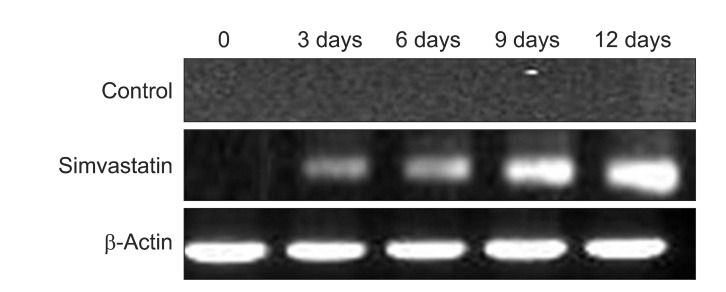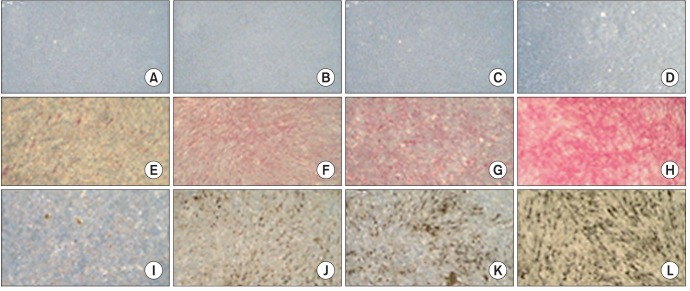J Korean Assoc Oral Maxillofac Surg.
2013 Aug;39(4):150-155.
Osteogenic potential of adult stem cells from human maxillary sinus membrane by Simvastatin in vitro: preliminary report
- Affiliations
-
- 1Department of Oral and Maxillofacial Surgery, The Catholic University of Korea, St. Paul's Hospital, Seoul, Korea.
- 2Department of Oral and Maxillofacial Surgery, The Catholic University of Korea School of Medicine, Seoul, Korea. jupark@catholic.ac.kr
Abstract
OBJECTIVES
The objective of this study is to determine the adequate concentration and to evaluate the osteogenic potential of simvastatin in human maxillary sinus membrane-derived stem cells (hSMSC).
MATERIALS AND METHODS
Mesenchymal stem cells derived from the human maxillary sinus membrane were treated with various concentrations of simvastatin. The adequate concentration of simvastatin for osteogenic induction was determined using bone morphogenetic protein (BMP-2). The efficacy of osteogenic differentiation of simavastatin was verified using osteocalcin mRNA, and the mineralization efficacy of hSMSCs and simvastatin treatment was compared with alkaline phosphatase and von Kossa staining.
RESULTS
Expression of BMP-2 mRNA and protein was observed after three days and was dependent on the concentration of simvastatin. Expression of osteocalcin mRNA was observed after three days in the 1.0 microM simvastatin-treated group. Mineralization was observed after three days in the simvastatin-treated group.
CONCLUSION
These results suggest that simvastatin induces the osteogenic potential of mesenchymal stem cells derived from the human maxillary sinus membrane mucosa.
Keyword
MeSH Terms
Figure
Reference
-
1. Ferrari G, Cusella-De Angelis G, Coletta M, Paolucci E, Stornaiuolo A, Cossu G, et al. Muscle regeneration by bone marrow-derived myogenic progenitors. Science. 1998; 279:1528–1530. PMID: 9488650.
Article2. Gussoni E, Soneoka Y, Strickland CD, Buzney EA, Khan MK, Flint AF, et al. Dystrophin expression in the mdx mouse restored by stem cell transplantation. Nature. 1999; 401:390–394. PMID: 10517639.
Article3. Kocher AA, Schuster MD, Szabolcs MJ, Takuma S, Burkhoff D, Wang J, et al. Neovascularization of ischemic myocardium by human bone-marrow-derived angioblasts prevents cardiomyocyte apoptosis, reduces remodeling and improves cardiac function. Nat Med. 2001; 7:430–436. PMID: 11283669.
Article4. Orlic D, Kajstura J, Chimenti S, Jakoniuk I, Anderson SM, Li B, et al. Bone marrow cells regenerate infarcted myocardium. Nature. 2001; 410:701–705. PMID: 11287958.
Article5. Alison MR, Poulsom R, Jeffery R, Dhillon AP, Quaglia A, Jacob J, et al. Hepatocytes from non-hepatic adult stem cells. Nature. 2000; 406:257. PMID: 10917519.
Article7. Johnstone B, Hering TM, Caplan AI, Goldberg VM, Yoo JU. In vitro chondrogenesis of bone marrow-derived mesenchymal progenitor cells. Exp Cell Res. 1998; 238:265–272. PMID: 9457080.8. Wakitani S, Saito T, Caplan AI. Myogenic cells derived from rat bone marrow mesenchymal stem cells exposed to 5-azacytidine. Muscle Nerve. 1995; 18:1417–1426. PMID: 7477065.
Article9. Pittenger MF, Mackay AM, Beck SC, Jaiswal RK, Douglas R, Mosca JD, et al. Multilineage potential of adult human mesenchymal stem cells. Science. 1999; 284:143–147. PMID: 10102814.
Article10. Bruder SP, Jaiswal N, Haynesworth SE. Growth kinetics, self-renewal, and the osteogenic potential of purified human mesenchymal stem cells during extensive subcultivation and following cryopreservation. J Cell Biochem. 1997; 64:278–294. PMID: 9027588.
Article11. Gruber R, Kandler B, Fuerst G, Fischer MB, Watzek G. Porcine sinus mucosa holds cells that respond to bone morphogenetic protein (BMP)-6 and BMP-7 with increased osteogenic differentiation in vitro. Clin Oral Implants Res. 2004; 15:575–580. PMID: 15355400.
Article12. Haas R, Donath K, Födinger M, Watzek G. Bovine hydroxyapatite for maxillary sinus grafting: comparative histomorphometric findings in sheep. Clin Oral Implants Res. 1998; 9:107–116. PMID: 9663038.
Article13. Kim SW, Lee IK, Yun KI, Kim CH, Park JU. Adult stem cells derived from human maxillary sinus membrane and their osteogenic differentiation. Int J Oral Maxillofac Implants. 2009; 24:991–998. PMID: 20162102.14. Mundy G, Garrett R, Harris S, Chan J, Chen D, Rossini G, et al. Stimulation of bone formation in vitro and in rodents by statins. Science. 1999; 286:1946–1949. PMID: 10583956.
Article15. Oxlund H, Dalstra M, Andreassen TT. Statin given perorally to adult rats increases cancellous bone mass and compressive strength. Calcif Tissue Int. 2001; 69:299–304. PMID: 11768201.
Article16. Oxlund H, Andreassen TT. Simvastatin treatment partially prevents ovariectomy-induced bone loss while increasing cortical bone formation. Bone. 2004; 34:609–618. PMID: 15050891.
Article17. Takahashi Y, Yamamoto M, Tabata Y. Enhanced osteoinduction by controlled release of bone morphogenetic protein-2 from biodegradable sponge composed of gelatin and beta-tricalcium phosphate. Biomaterials. 2005; 26:4856–4865. PMID: 15763265.18. Li H, Dai K, Tang T, Zhang X, Yan M, Lou J. Bone regeneration by implantation of adipose-derived stromal cells expressing BMP-2. Biochem Biophys Res Commun. 2007; 356:836–842. PMID: 17391646.
Article19. Song I, Kim BS, Kim CS, Im GI. Effects of BMP-2 and vitamin D3 on the osteogenic differentiation of adipose stem cells. Biochem Biophys Res Commun. 2011; 408:126–131. PMID: 21463608.
Article20. Sumanasinghe RD, Bernacki SH, Loboa EG. Osteogenic differentiation of human mesenchymal stem cells in collagen matrices: effect of uniaxial cyclic tensile strain on bone morphogenetic protein (BMP-2) mRNA expression. Tissue Eng. 2006; 12:3459–3465. PMID: 17518682.
Article21. Cho HH, Park HT, Kim YJ, Bae YC, Suh KT, Jung JS. Induction of osteogenic differentiation of human mesenchymal stem cells by histone deacetylase inhibitors. J Cell Biochem. 2005; 96:533–542. PMID: 16088945.
Article22. Park JB. Use of cell-based approaches in maxillary sinus augmentation procedures. J Craniofac Surg. 2010; 21:557–560. PMID: 20216438.
Article23. Kimelman N, Pelled G, Helm GA, Huard J, Schwarz EM, Gazit D. Review: gene- and stem cell-based therapeutics for bone regeneration and repair. Tissue Eng. 2007; 13:1135–1150. PMID: 17516852.
Article24. Moioli EK, Clark PA, Xin X, Lal S, Mao JJ. Matrices and scaffolds for drug delivery in dental, oral and craniofacial tissue engineering. Adv Drug Deliv Rev. 2007; 59:308–324. PMID: 17499385.
Article25. Donzelli E, Salvadè A, Mimo P, Viganò M, Morrone M, Papagna R, et al. Mesenchymal stem cells cultured on a collagen scaffold: In vitro osteogenic differentiation. Arch Oral Biol. 2007; 52:64–73. PMID: 17049335.
Article26. Thesleff I, Tummers M. Stem cells and tissue engineering: prospects for regenerating tissues in dental practice. Med Princ Pract. 2003; 12(Suppl 1):43–50. PMID: 12707500.
Article27. Woll NL, Heaney JD, Bronson SK. Osteogenic nodule formation from single embryonic stem cell-derived progenitors. Stem Cells Dev. 2006; 15:865–879. PMID: 17253949.
Article28. Kärner E, Unger C, Sloan AJ, Ahrlund-Richter L, Sugars RV, Wendel M. Bone matrix formation in osteogenic cultures derived from human embryonic stem cells in vitro. Stem Cells Dev. 2007; 16:39–52. PMID: 17233553.
Article29. Jackson L, Jones DR, Scotting P, Sottile V. Adult mesenchymal stem cells: differentiation potential and therapeutic applications. J Postgrad Med. 2007; 53:121–127. PMID: 17495381.
Article30. Weiss ML, Troyer DL. Stem cells in the umbilical cord. Stem Cell Rev. 2006; 2:155–162. PMID: 17237554.
Article31. Gimble J, Guilak F. Adipose-derived adult stem cells: isolation, characterization, and differentiation potential. Cytotherapy. 2003; 5:362–369. PMID: 14578098.
Article32. Song C, Guo Z, Ma Q, Chen Z, Liu Z, Jia H, et al. Simvastatin induces osteoblastic differentiation and inhibits adipocytic differentiation in mouse bone marrow stromal cells. Biochem Biophys Res Commun. 2003; 308:458–462. PMID: 12914771.
Article33. Liu S, Bertl K, Sun H, Liu ZH, Andrukhov O, Rausch-Fan X. Effect of simvastatin on the osteogenetic behavior of alveolar osteoblasts and periodontal ligament cells. Hum Cell. 2012; 25:29–35. PMID: 22399266.
Article34. Ozeç I, Kiliç E, Gümüş C, Göze F. Effect of local simvastatin application on mandibular defects. J Craniofac Surg. 2007; 18:546–550. PMID: 17538316.
- Full Text Links
- Actions
-
Cited
- CITED
-
- Close
- Share
- Similar articles
-
- Biomimetic Polymer Scaffolds to Promote Stem Cell-Mediated Osteogenesis
- The Osteogenic Role of Biomaterials Combined with HumanDerived Dental Stem Cells in Bone Tissue Regeneration
- Comparison of Dipogenic and Osteogenic Potentials of Visceral and Subcutaneous Adipose Stem Cells of Human
- An Implant for Bone Formation using Autologous Mesenchymal Stem Cells
- Osteogenic Potential of Human Mesenchymal Stem Cells During Serial Subculture





